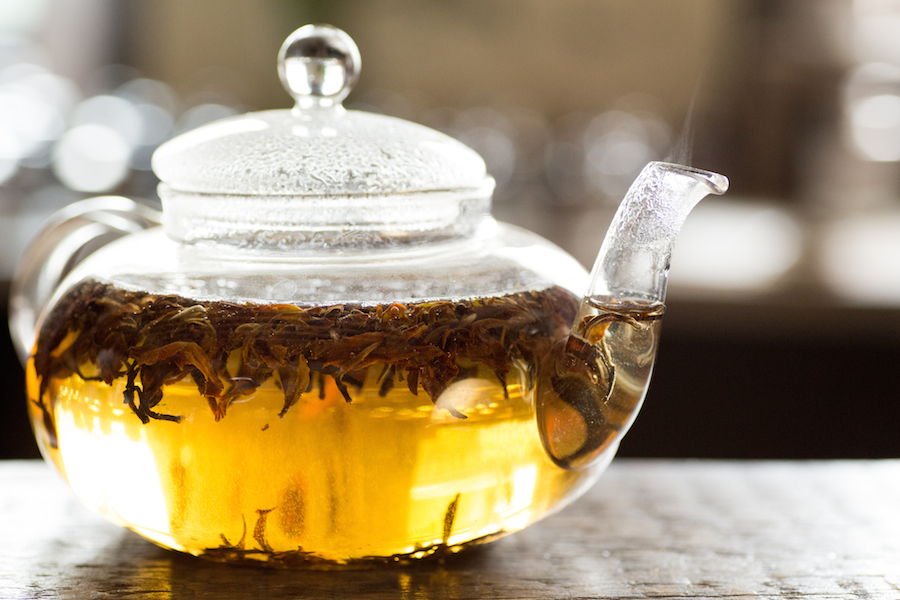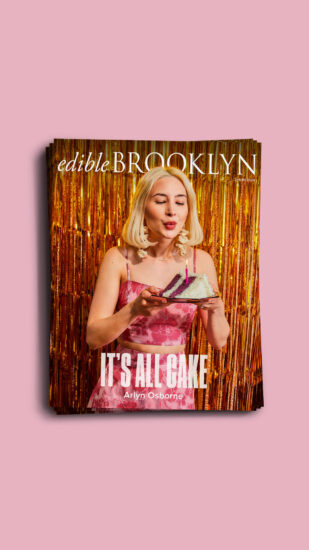The dark brown, galvanized double-doors that lead to Bellocq Tea Atelier in Greenpoint offer no windows to peek through. In fact, the cracked concrete just outside them in this once-industrial corner of West Street makes this seem like an unlikely respite. And technically, it’s not. Bellocq isn’t a salon meant for drinking tea and nibbling scones, but instead blends, packages and sells whole-leaf organic tea and tisanes, both inspired by and sourced on the owners’ travels to faraway continents. They sell to both walk-in tea aficionados — many who come from as far as Asia and South America to buy straight from the source — and wholesale customers like Bergdorf Goodman, Saxon & Parole or The Butcher’s Daughter.
But you may well end up here sipping on a perfectly brewed cup poured from the ever-full glass pot, warmed by a tea light perched on the worn-wood counter, and engaging in fanciful conversation that seems to have absolutely nothing to do with tea and yet you’ll find is often the romantic, left-of-center inspiration behind co-owner Heidi Johannsen’s haunting blends.
Just get her talking about the idea behind, say, blend No. 12, aka Le Hammeau, and you’ll find yourself settling into the faded rose-colored seats in the back room and listening to her soliloquy on the scent of the “peasant” clothing worn by Marie Antoinette at Versailles — the ham eau — that she donned to milk cows in her pretend rustic village.
“She used to bring her children with her and I wonder about the way she smelled to them when she’d take them into her arms — the cotton of her clothes and the milk and the hay,” says Johannsen, both dreamy and smiling as she sips on a small glass cup of the No. 12, which does indeed smell like a country garden or an expansive meadow full of grass and wildflowers warmed by the sun.
“Scent,” she continues, “is a fascinating tool.”
As is sight. The name of this very stylized shop, which began in 2010 as a yearlong London pop-up when Johannsen’s husband was there working on a project, comes from the early-20th-century French-Creole New Orleans photographer E. J. Bellocq, who often snapped his shots in the seedy long-gone red light district called Storyville, known more for its prostitutes than pralines.
“It’s not an homage to him,” clarifies Johannsen, “but it’s about seeing beauty where other people don’t.”
Johannsen’s two partners in Bellocq are very good at that as well. One is her husband, the artist and architect Scott Stewart, who created the pretty, plum-hued, fern-draped, antique- and teapot-dotted interior of the Brooklyn Bellocq, which opened in 2011. His architectural design company, SAAW, crafts stunning spaces for Anthropologie and Barneys. The other is Michael Shannon, who worked alongside Johannsen as a product designer for 10 years at Martha Stewart Omnimedia, which she joined as a food editor in 1997 after attending the French Culinary Institute.
That ability to seek out lovely things is part and parcel to the 20 blends that Johannsen creates herself, and that make up a third of what’s presently on offer from Bellocq, the rest pure specimens like puerhs, lapsong souchongs, dried wild white peonies and the like. (Some are certified organic; the rest are working with good sustainable practices.)
Johannsen’s blends require a thorough understanding of the plant (Camellia sinensis, that is, from which all teas originate and that grows in places including Japan, Sri Lanka, China, India, Taiwan and Kenya); its leaves and what they’re like at first flush as well as in maturity; how it may grow in different climates and countries and how it is processed there; not to mention a botanist’s familiarity with the blending elements used — lavender, rose, cedar, marigold, bergamot and a host of other aromatically inclined botanicals.
Indeed, you might say Johannsen sees things in tea-vision: Her pretty sunflower-yellow packaged creations often feel as if they arrived from an otherworldly plane.
Take No. 45, the White Wolf, a tea she dreamt up for autumn and winter-centric sipping.
“Sometimes I have an image in mind,” she says, elegantly sweeping her hand in the air as if to conjure up her original vision. “I kept imagining the horizon in the West in winter. In Wyoming, maybe. I imagined riding a horse in the cold, with the frozen grass crunching under his hooves and creak of the saddle, but the warm smells coming from the horse’s hair, the leather, the wind. And seeing a gray sky, all silvery on the horizon….”
What did that translate to? A Chinese white tea-base called Pai Mu Tan, which smells like leather and hay via its blend of red cedar tips, black currant leaf, smoked peppercorn and vanilla. A fairy tale that you can drink.
Johannsen likes to use her tea blends to flavor simple but complexly flavored cocktails. Now you can, too: get the recipe for her White Duke Gimlet here.



